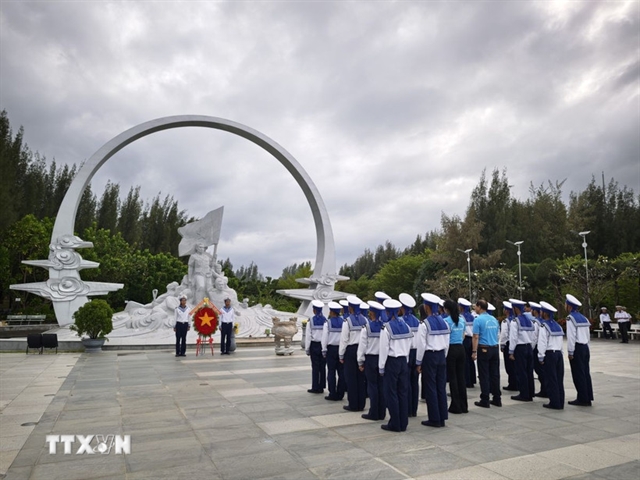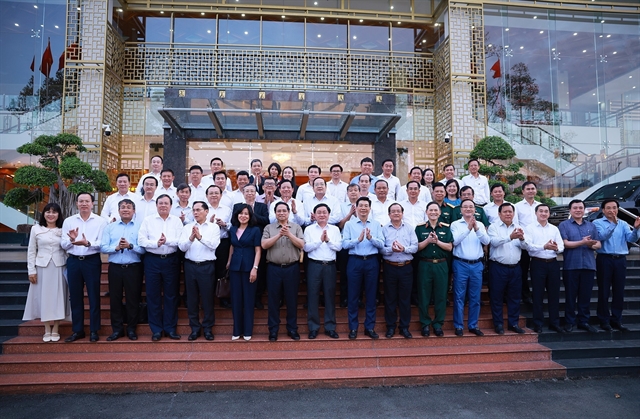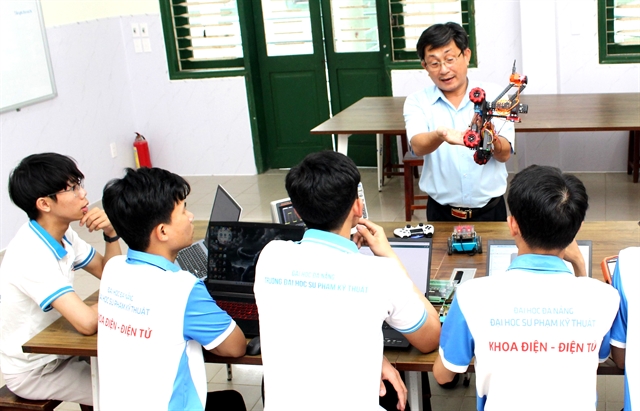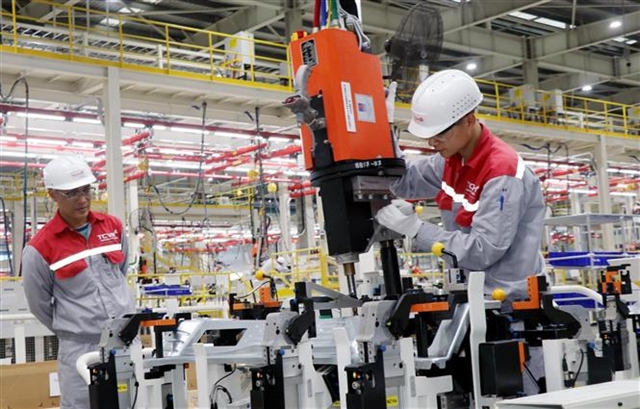 Society
Society

 |
| Students of Hà Nội National University of Education on the day of admission in September.— VNA/VNS Photo Thanh Tùng |
HÀ NỘI — As artificial intelligence (AI) reshapes education, the role of teachers is evolving from transmitters of knowledge to mentors who inspire, guide and nurture lifelong learners, proving that even in a high-tech world, humanity remains central to teaching.
Associate Professor Bùi Đình Hợi, lecturer at the Faculty of Physics, University of Education under Huế University, said that AI is changing not only what and how we learn, but also who we learn from.
“Yet, the teacher’s role is not disappearing, it is being redefined,” he told Giáo dục và Thời đại (Education and Times) online newspaper.
If in the past teachers mainly delivered knowledge, they now act as guides on the learning journey, helping students to think critically, select and evaluate information in a world overflowing with data.
Beyond academics, teachers remain vital in nurturing emotional engagement, igniting passion and cultivating character and values.
“AI can teach students what to know, but only humans can teach them how to be,” he said.
Even as AI can assist with lesson planning, marking, assessment and even teaching, Hợi believes the essence of teaching—its humanity and emotional connection—can never be replicated by machines.
“AI is brilliant at processing data, but it cannot empathise, show compassion or love a student the way a teacher does,” he said.
Only a human teacher can perceive a pupil’s strengths and weaknesses, understand their circumstances and emotions, and guide them personally.
“AI may help students become smarter, but only teachers can help them become better people,” he added.
Associate Professor Trần Thành Nam, Vice Principal of the University of Education under the Việt Nam National University, Hà Nội, shares the perspective.
He describes the AI era as an opportunity for teaching to “return to the core values of education.”
The role of teachers is shifting from traditional lecturing to designing learning journeys, shaping emotions and inspiring students.
AI is transforming the classic teacher-student model into a teacher–AI–student model, requiring educators to collaborate with technology and harness its potential effectively.
“The core human values of a teacher can never be replaced, especially in the mission of educating people,” he said.
Teachers develop character, inspire, and shape students through their own example.
Ideals such as aspiration, compassion, love of one’s homeland and community spirit “can only be passed from human to human,” he said.
Beyond teaching, teachers also serve as mentors and counsellors, offering empathy, guidance and support in developing critical thinking and self-awareness.
“No technology can replace the teacher’s essential role in moral and personal development,” he said.
 |
| A lecturer of the University of Technical Education - Đà Nẵng University teaches semiconductor circuit design, a major that applies many digital transformation learning methods.— VNA/VNS Photo Văn Dũng |
Reinventing teacher training
The inevitable shift in the teacher’s role demands corresponding reform in teacher education.
Cao Hồng Huệ, senior lecturer at the Institute of Information Technology and Deputy Director of the Centre for Communication and Learning Resources, Hà Nội Pedagogical University 2, said the focus must move from merely imparting professional knowledge to developing digital literacy and creative capacity among students.
Circular No. 02/2025/TT-BGDĐT, which sets out Việt Nam’s Digital Competence Framework for Learners, defines six key domains, consisting of data and information literacy; digital communication and collaboration; digital content creation; digital safety; problem solving; and the application of AI.
The competencies should be built into teacher training from the outset.
To implement the circular, the Ministry of Education and Training has issued two key guidance documents – Official Dispatch No. 3456/BGDĐT-GDPT for general education and No. 2957/BGDĐT-GDĐH for higher education.
The underlying philosophy of the documents is that digital competence must be introduced in schools and reinforced in universities, particularly in teacher-training institutions that prepare future educators.
Associate Professor Hợi said that teacher education must make a decisive shift from knowledge transmission to competence and technological adaptation.
Pedagogical universities should strengthen practice-oriented training linked with digital tools, from designing e-lessons to managing virtual classrooms, and work closely with schools so that student teachers can experience how technology is applied in real teaching environments.
Equally important is cultivating a lifelong learning mindset.
“Teachers of the 21st century must be ready to relearn, update and renew themselves,” he said.
To thrive in the new landscape, Hợi highlights three crucial skill groups for teachers.
The first skill is digital competence, the ability to use and apply AI effectively, ethically and creatively in teaching.
The second skill is adaptability and lifelong learning.
And most vital of all is humanistic capacity, including empathy, understanding and the ability to inspire students.
He cautions that over-reliance on AI can lead to what experts call a “competence trap,” dulling human thinking and creativity.
Users, including students, must learn to use AI wisely and moderately.
Associate Professor Trần Thành Nam outlines several fundamental reforms for teacher training institutions.
First, develop new teacher competency frameworks and update curricula accordingly.
Educators of the AI age must possess a clearly defined set of digital and ethical competencies.
He refers to UNESCO’s AI Competency Framework for Teachers, which includes 15 core competencies across five domains of human-centred thinking, AI ethics, foundational knowledge and application, AI-integrated pedagogy, and using AI for professional growth.
The framework offers a valuable reference for countries.
Việt Nam has already introduced national programmes to strengthen digital and AI skills among teachers and to integrate AI into teaching and school management.
Teacher-training universities must swiftly embed the competencies into learning outcomes and curricula to ensure graduates meet modern teaching standards.
Second, integrate technology and AI throughout the training process.
Institutions must invest in digital infrastructure, provide hands-on access to AI tools and offer training for both lecturers and students.
AI should be embedded in all teaching modules, from lesson design to assessment, so that students develop practical, applicable skills.
Third, reform teaching methods and educational philosophy. Outdated pedagogy cannot produce 21st-century teachers. Programmes must shift towards learner-centred, creative and self-directed education, encouraging personalised and experiential learning.
Fourth, embed digital ethics and ensure legal safeguards. Students must understand professional ethics in the digital era, while the State needs to establish a legal framework for AI use in education.
Finally, build open, collaborative ecosystems. No institution can innovate alone. Universities should partner closely with schools, EdTech firms, international organisations and local communities to exchange knowledge and co-develop modern training systems.
Each institution should also strengthen international collaboration and participate in global research networks to stay at the forefront of educational innovation.
A roadmap for renewal
Educational specialist Ngô Huy Tâm, curriculum designer at the University of Houston (USA), proposes a comprehensive, three-phase roadmap for reforming Việt Nam’s teacher-training system, based on international experience and UNESCO standards.
Phase 1 (2025–27) is raising awareness and pilot testing.
The stage focuses on building shared understanding. Pedagogical universities should organise workshops and training sessions on AI in education, while launching pilot projects in selected faculties to test new tools and methods.
Phase 2 (2028–30) is full integration and curriculum adaptation.
This requires systemic reform, reviewing and updating all training programmes to embed digital literacy and AI pedagogy.
“This is essential to prepare teachers for the Fourth Industrial Revolution,” he said.
Phase 3 (post-2030) is innovation and leadership.
At this stage, leading Vietnamese universities must move beyond adaptation to global leadership.
They should introduce specialised training and even master’s programmes in AI in Education (AIED), similar to Singapore’s National Institute of Education (NIE). Research into educational AI and 'Made in Việt Nam' learning platforms should be accelerated to fit local curricula and cultural contexts.
"True reform goes far beyond a few workshops or an elective on AI for Teachers,” he said.
Real innovation, as Finland’s experience shows, requires integrating AI pedagogy into every subject area.
Future maths teachers should learn to use adaptive learning platforms to personalise student exercises; future history teachers should learn to create virtual museum tours or AI-powered historical simulations.
“This demands every lecturer in teacher education to become an expert in AI pedagogy within their discipline – a challenge, but also a strategic mission for Việt Nam’s higher education sector,” he said. “Teacher-training institutions must take the lead.”
Students should not just learn about technology, they must live in a digital learning environment, practise teaching on LMS and e-learning platforms, and use AI to provide feedback, assessment and digital materials.
“Only then will they be ready to guide their own pupils in developing the digital competencies set by the ministry,” Huệ said. — VNS




